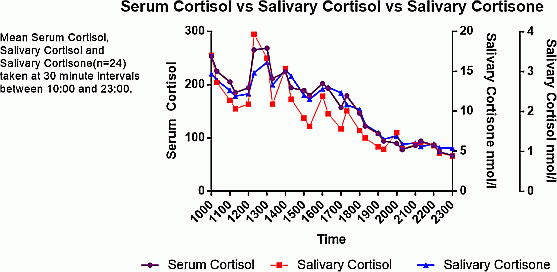SFEBES2016 Poster Presentations Adrenal and Steroids (41 abstracts)
Salivary cortisone is a potential surrogate for serum cortisol measurement
Safwaan Adam 1, , Anna Minder 2 , Elizabeth Cottrell 1 , Alison Davies 1 , Suzanne Meredith 1 , Richard Preziosi 1 , Brian Keevil 3 , Claire Higham 2, , Anne White 1 & Peter Trainer 2,
1Faculty of Biology, Medicine and Health, University of
Manchester, Manchester, UK; 2The Christie Hospital NHS Foundation Trust, Manchester, UK; 3University Hospital of South Manchester, Manchester, UK; 4Manchester Academic Health Sciences Centre, University of Manchester, Manchester, UK.
Introduction: Hydrocortisone therapy in adrenal insufficiency and medical management of Cushing’s syndrome requires accurate monitoring of glucocorticoid status. Currently, this necessitates admitting patients to hospital for serial measurements of serum cortisol. From previous studies in Cushing’s, the goal of medical therapy is a mean (based on five samples) serum cortisol of 150–300 nmol/l, which is known to equate to a normal cortisol production rate. Salivary cortisol has the virtue of convenience and being unaffected by variation in CBG but cross-reactivity is a problem on immunoassay. Oral contamination can result in spuriously high salivary cortisol (but not cortisone) levels in patients on hydrocortisone. Cortisone, converted from cortisol, is quantitatively the predominant glucocorticoid in saliva and its measurement has the potential to overcome the limitations of salivary cortisol. We have studied the value of salivary glucocorticoids (measured by LC–MS/MS) as a patient-friendly surrogate for serum cortisol measurement.
Methods: Serum cortisol and salivary cortisol and cortisone were measured in 24 healthy volunteers (12 BMI <25; 12 BMI 25–30) every 30 min from 1000 to 2300 h. Standard meals were given at 1200, 1700 and 2100 h.
Results: Mean serum cortisol was 253 nmol/l (1000 h) and 67 nmol/l (2300 h). Pulses in serum cortisol were mimicked in salivary glucocorticoid measurements with close correlation between serum cortisol and salivary cortisol (r=0.78; P<0.0001) or salivary cortisone (r=0.83; P<0.0001). In this study, the mean of five samples (1000, 1300, 1600, 1900, 2200 h) ranged from 100–265 nmol/l for serum cortisol, 1.0–5.4 nmol/l for salivary cortisol and 6.7–18.7 nmol/l for salivary cortisone. Furthermore, the mean salivary cortisone based on five samples was representative of the mean from all 26 samples per subject (r=0.88; P<0.001).
Conclusions: Salivary cortisone accurately reflects ultradian changes in serum cortisol (better than salivary cortisol) and offers a convenient alternative to venous sampling in patients with disorders of the HPA axis.





